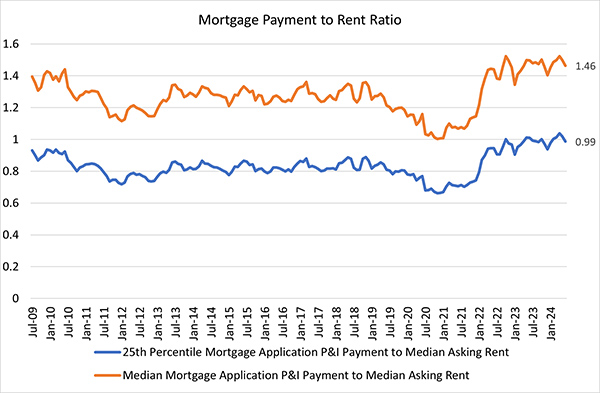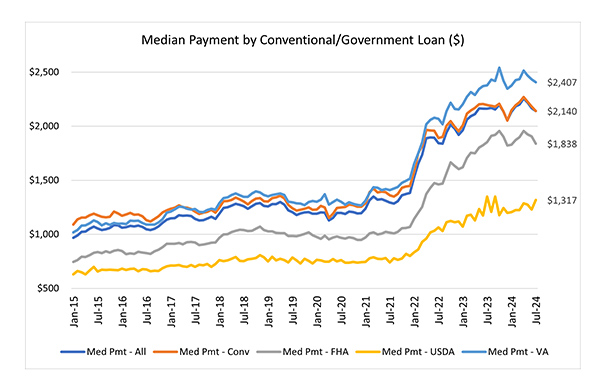
Mortgage Application Payments Decreased 1.3% to $2,140 in July

(Image courtesy of MBA)
Homebuyer affordability improved in July, with the national median payment applied for by purchase applicants decreasing to $2,140 from $2,167 in June. This is according to the Mortgage Bankers Association’s (MBA) Purchase Applications Payment Index (PAPI), which measures how new monthly mortgage payments vary across time – relative to income – using data from MBA’s Weekly Applications Survey (WAS).
“Homebuyer affordability conditions improved for the third consecutive month as rates below 7% and rising housing inventory continue to bode well for prospective homebuyers,” said Edward Seiler, MBA’s Associate Vice President, Housing Economics, and Executive Director, Research Institute for Housing America. “MBA is expecting that slower home-price appreciation, coupled with lower rates, will ease affordability constraints and lead to increased activity in the housing market.”
An increase in MBA’s PAPI – indicative of declining borrower affordability conditions – means that the mortgage payment to income ratio (PIR) is higher due to increasing application loan amounts, rising mortgage rates, or a decrease in earnings. A decrease in the PAPI – indicative of improving borrower affordability conditions – occurs when loan application amounts decrease, mortgage rates decrease, or earnings increase.
The national PAPI decreased 1.9% to 167.7 in July from 170.9 in June. Median earnings were up 2.9% compared to one year ago, and while payments decreased 1%, the moderate earnings growth means that the PAPI is down 3.8% on an annual basis. For borrowers applying for lower-payment mortgages (the 25th percentile), the national mortgage payment decreased to $1,444 in July from $1,460 in June.
MBA’s national mortgage payment to rent ratio (MPRR) decreased from 1.50 at the end of the first quarter (March 2024) to 1.46 at the end of the second quarter (June 2024), meaning mortgage payments for home purchases have increased relative to rents. The Census Bureau’s HVS national median asking rent in second-quarter 2024 increased to $1,481 ($1,469 in first-quarter 2024). The 25th percentile mortgage application payment to median asking rent ratio increased to 0.99 in June (1.01 in March 2024).
The Builders’ Purchase Application Payment Index (BPAPI) showed that the median mortgage payment for purchase mortgages from MBA’s Builder Application Survey decreased to $2,452 in June from $2,510 in June.


Additional Key Findings of MBA’s Purchase Applications Payment Index (PAPI) – July 2024
• The national median mortgage payment was $2,144 in July—down $27 from June. It is down by $22 from one year ago, equal to a 1% decrease.
• The national median mortgage payment for FHA loan applicants was $1,838 in July, down from $1,907 in June and down from $1,854 in July 2023.
• The national median mortgage payment for conventional loan applicants was $2,180, down from $2,140 in June and down from $2,197 in July 2023.
• The top five states with the highest PAPI were: Nevada (255.5), Idaho (252.8), Arizona (224.6), Rhode Island (215.2), and Tennessee (211.2).
• The top five states with the lowest PAPI were: Louisiana (119.8), New York (122.7), Connecticut (129.8), West Virginia (133.1), and Kansas (134.6).
• Homebuyer affordability increased for Black households, with the national PAPI decreasing from 171.4 in June to 168.2 in July.
• Homebuyer affordability increased for Hispanic households, with the national PAPI decreasing from 159.5 in June to 156.5 in July.
• Homebuyer affordability increased for White households, with the national PAPI decreasing from 172.6 in June to 169.4 in July.
About MBA’s Purchase Applications Payment Index
The Mortgage Bankers Association’s Purchase Applications Payment Index (PAPI) measures how new mortgage payments vary across time relative to income. Higher index values indicate that the mortgage payment to income ratio (PIR) is higher than in a month where the index is lower. Contrary to other affordability indexes that make multiple assumptions about mortgage underwriting criteria to estimate mortgage payment level, PAPI directly uses MBA’s Weekly Applications Survey (WAS) data to calculate mortgage payments.
PAPI uses usual weekly earnings data from the U.S. Bureau of Labor Statistics’ Current Population Survey (CPS). Usual weekly earnings represent full-time wage and salary earnings before taxes and other deductions and include any overtime pay, commissions, or tips usually received. Note that data are not seasonally adjusted.
MBA’s Builders’ Purchase Application Payment Index (BPAPI) uses MBA’s Builder Application Survey (BAS) data to create an index that measures how new mortgage payments vary across time relative to income, with a focus exclusively on newly built single-family homes. As with PAPI, higher index values indicate that the mortgage payment to income ratio (PIR) is higher than in a month where the index is lower. To create BPAPI, principal and interest payment amounts are deflated by the same earnings series as in PAPI.
The rent data series calculated for MBA’s national mortgage payment to rent ratio (MPRR) comes from the U.S. Census Bureau’s Housing Vacancies and Homeownership (HVS) survey’s median asking rent. The HVS data is quarterly, and as such, the mortgage payment to rent ratio will be updated quarterly. The HVS data is quarterly, and as such, the mortgage payment to rent ratio will be updated quarterly.
For additional information on MBA’s Purchase Applications Payment Index, click here.
